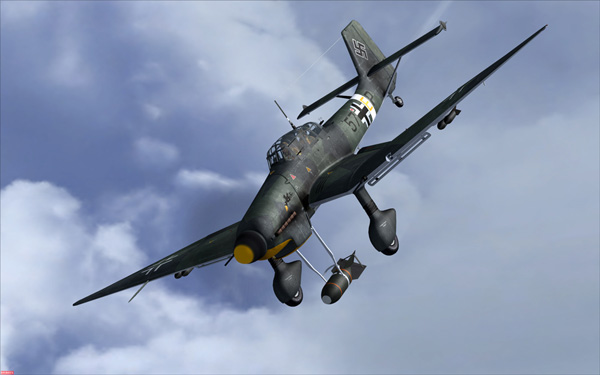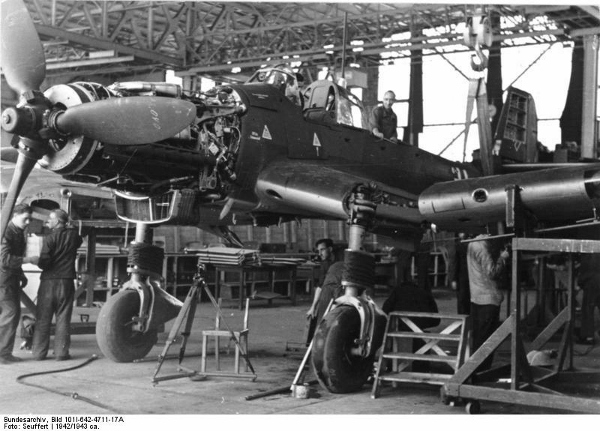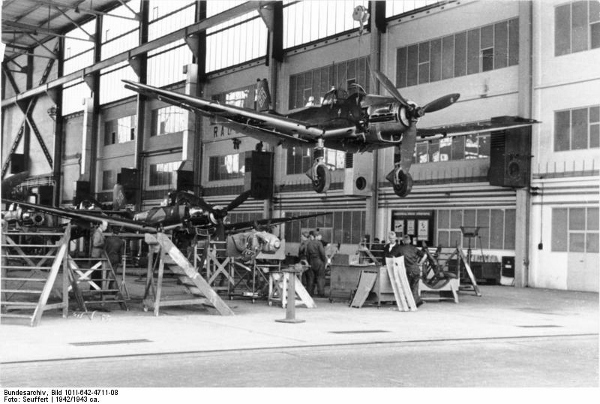
|
 |
The Stuka by Larry Dwyer |
 |
 |
 |
 |
 |
|---|---|---|---|---|---|---|---|
 |
 |
 |
 |
 |
|||
 |
||
|
It was the scourge of World War II and no other aircraft terrorized its victims as much as the Junkers Ju 87 Stuka. Stuka was an abbreviated form of Sturzkampfflugzeug or literally "diving fighting plane". Only later was it applied specifically to the Ju 87 Stuka.
The Stuka was instantly recognizable with its inverted gull wings, fixed spatted undercarriage and infamous Jericho-Trompete ("Jericho Trumpet") wailing siren. It made its combat debut with the Condor Legion during the Spanish Civil War and was very accurate against ground targets. For the German commanders, the Stuka was their flying artillery. However, it was vulnerable to the more nimble fighters of the day, such as the Spitfire and Hurricane, and required fighter top-cover for protection in order to complete its missions successfully. First flown on September 17, 1935, it was already considered obsolete at the start of World War II. However, because of its early success and with no other alternative readily available, it would remain in production until almost the end of the war. |
| It was designed by Hermann Pohlmann of Junkers, at the insistence of Ernst Udet, who pushed it to the forefront of German aviation development. After observing Curtiss Hawk dive-bombers at a Cleveland air show in 1933, Udet brought two Curtiss BFC-1 Hawks back to Germany and provided his own show. He dove from 1,000 m (3,280 ft) releasing his bombs at 100 m (330 ft), before pulling out.1 |
|
But it wasn’t so easy convincing the Luftwaffe that the Stuka was feasible. Before Udet was allowed to perform his own tests, one of the conditions for purchasing the Hawks was that Luftwaffe would perform their own test first. The dive maneuvers prove so physically exhausting that test pilots had to be physically lifted out of the cockpit after landing. The concept was rejected as being dangerous, impractical and unsuitable for military operations. Undaunted, Udet continued performing his own test, but was nearly killed during one dive when the hawk failed to respond to the controls. Udet bailed out just in time and opened his chute only yards away from the ground.
Generalleutnant Wolfram Freiherr von Richthofen, a cousin of the famous World War I ace, feared that such high-level nerves and skill could not be expected of the average Luftwaffe pilot, but he was overridden by the Chief of the Luftwaffe Command Office, Walther Wever, and the Secretary of State for Aviation, Erhard Milch. Publically the Luftwaffe rejected Udet’s (a civilian pilot at the time) idea, because it would be a violation of the Treaty of Versailles. However, secretly they were preparing to adopt the Stuka concept. The United States was still conducting similar tests and the Japanese were also doing the same. The Luftwaffe saw in the new plane, a great opportunity to improve the accuracy of bombing. A few Stukas could achieve much better results than an entire squadron of horizontal bombers.2 The Stuka would have to be strong enough to withstand a 350 mph (563 km/h) dive and required dive-brakes to prevent the airplane from exceeding speeds to where it could be operated safely. To meet this criteria, the Stuka would incorporate an interesting feature which consisted of automatic pull-up dive-brakes that leveled the plane out if the pilots blacked out during dive maneuvers. Experience showed that about half of the pilots would black out when pulling five Gs to recover.

In April 1935, the firms of Arado, Blöhm und Voss, Heinkel, and Junkers were requested to begin work on dive-bomber prototypes, but Junkers had the advantage with earlier Swedish-built K-47 and K-48 models that had already proven successful in vertical dive tests.3 With these models to build on, the prototype Ju 87 V1 was built in just a few months and production models began arriving in 1937. On August 15, 1939, just two weeks before the invasion of Poland, serious doubts were raised again about safety of the Stuka. Stuka Geschwader 76 was conducting practice bombing runs using cement practice bombs before a contingent of high-ranking Luftwaffe officials. The target area was 3,000 feet below a heavy overcast with a ceiling of 3,000 Above Ground Level (AGL). Flying at 12,000 feet, the formation performed their bombing run in three groups, one behind the other. Unknown to the formation, the weather conditions had changed and a ground fog developed. Instead of emerging from the cloud bank into clear weather, the ground target was obscured by haze. When the target finally became visible, the first group realized that they were closer than expected. The commander, Hauptmann Walter Sigel called over the radio to pull up, but not all pilots were able to recover in time. Sigel pulled up in time, just skimming the trees, but his wingmen plowed straight into the forest. All nine of the second group crashed and the last group was able to recover in time. A total of thirteen aircraft and twenty-six airmen would die in what would be known as the “The Neuhammer Catastrophe.” Ironically, Generalleutnant Wolfram von Richthofen was one of the eyewitnesses to the tragedy. Despite the disasaster, the accident was blamed on weather and the Stuka would continue to play a role in the upcoming war.4 At the start of the war, the Stuka was very effective in France and during the Polish Blitzkrieg (lightning war). It was considered invincible, but what was not quite understood at the time, it excelled only when air superiority had been established. Finally, after being challenged by Spitfires and Hurricanes at Dunkirk, and after they took a severe mauling during the Battle of Britain in 1940, they were restricted to night-bombing missions and were removed from operations over Western Europe. However, it would suffer just as much later on, at the hands of Russian pilots flying Bell P-39 Airacobras, on the eastern front.5

As the war progressed, the strategy of the land dive-bomber had passed. However, dive-bombers still proved to be successful in the US Navy as can be attested by the success of the Curtiss SB2C Helldiver which sunk more ship tonnage than other aircraft during the war. However, the US Army gave up on land dive-bombers after one disaster when five out of seven A-24 Banshees were shot down by Japanese Zeros when sent to attack a Japanese convoy off Buna, New Guinea. A sixth plane was damaged so badly, it never made it back to base. The failure of the mission is attributed to the Army’s failing to provide top cover. Consequently, A-24s were relegated to non-combat duty.6 The Stuka remained the only dedicated land dive-bomber during the war, but it was a slow cumbersome airplane with poor defensive capabilities, that would haunt the German command. Despite its faults, Stukas were still devastating in Yugoslavia, Greece, North Africa and the Caucasus, when not opposed by Allied fighters. They were also flown by the Regia Aeronautica and it was nicknamed picchiatelli (little woodpecker). The Stuka has often been confused with the Breda 201, which was an Italian built single-seat dive-bomber. While the 201 does bear some resemblance with a less pronounced gull-wing, it differed in all other respects. All Ju 87s that served with the Regia Aeronautica were built in Germany.7 Other users were the Royal Romanian Air Force and Bulgarian Air Force.

The role of the dive-bomber would eventually be delegated to faster and far more nimble fighters such as the Focke-Wulf 190. Unlike the Stuka, fighter/bombers could drop their bombs and were able to defend themselves from attack. New bombs sites increased the accuracy of horizontal bombing, matching the precision of the dive-bomber. Oberst Hans-Ulrich Rudel was the most famous of the Stuka pilots and was the only recipient of the Knights Cross with Golden Oak Leaves, Swords and Diamonds. He flew a record 2,530 combat missions destroying 519 tanks, 150 artillery pieces, 70 landing craft, nine aircraft, several bridges, a destroyer, the Soviet battleship Marat and severely damaged the battleship October Revolution. He was forced down 30 times by artillery and ground fire, and lost a leg in February 1945. He was wounded a total of five times.8 Considering the aircraft’s performance and his length of service, it’s a wonder he survived at all.

Having fallen out of favor, the Ju 87 was finally resurrected near the end of the war as an anti-tank weapon and designated the Ju 87G. Two 30 mm (or 37-mm high-velocity) cannons in underwing pods were installed and it could carry a 1,000 kg (2,200 lb) free-fall bomb. It copied the armored protection of the Ilyushin Il-2 Sturmovik to protect the crew from ground fire required to conduct low level attacks. It wasn’t an easy airplane to fly, while aiming accurately at ground targets, and only the most experienced pilots were allowed to pilot it.9 Not many G models were built. The G-1 was converted from older D-series airframes, retaining the smaller wing, but without the dive brakes. The G-2 was similar to the G-1 except for use of the extended wing of the D-5. 208 G-2s were built and at least a further 22 more were converted from D-3 airframes. Approximately 6,500 aircraft were built, but less than 400 Ju 87 Stukas were in service at any one time. Despite its scarcity, it would leave an indelible impression very much out of proportion to its numbers. |
Endnotes:
|
1. David Mondey. The Concise Guide to Axis Aircraft of World War II. New York: Smithmark Publishers, 1996. 111. 2. Thomas Hajewski. The Stuka Story. Air Force Magazine.: Vol. 70, No. 5, May 1987. 3. J. Richard Smith. Aircraft in Profile, Volume 4, The Junkers Ju 87A & B. Garden City, New York: Doubleday & Company, Inc., 1968. 3. 4. John Weal. Junkers Ju 87 Stukageschwader. Oxford: Osprey Publishing, 1997. 1937-41. 19. 5. Dmitriy Loza. Attack of the Airacobras. Lawrence, Kansas: University Press of Kansas, 2002. 217. 6. Rob Stern and Don Greer. SBD Dauntless in Action. Carrollton, Texas: Squadron Signal Publications, 1984. 17. 7. Johnathon Thompson. Italian Civil and Military Aircraft, 1930-1945. Los Angeles: Aero Publishers Inc., 1963. 42. 8. Günther Fraschka. Knights of the Reich. Atglen, PA: Schiffer Publishing Ltd., 1989. 127-130. 9. J. R. Smith & Anthony Kay. German Aircraft of the Second World War. London: Putnam, 1985. 392. |
©Larry Dwyer. The Aviation History On-Line Museum.
All rights reserved.
Created January 1, 2014.